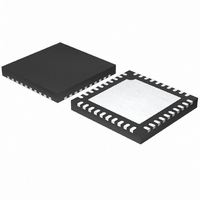MAX6975ATL+ Maxim Integrated Products, MAX6975ATL+ Datasheet - Page 11

MAX6975ATL+
Manufacturer Part Number
MAX6975ATL+
Description
IC LED DRIVER LINEAR 40-TQFN
Manufacturer
Maxim Integrated Products
Type
Linear (Serial Interface)r
Datasheet
1.MAX6975ATL.pdf
(23 pages)
Specifications of MAX6975ATL+
Topology
PWM
Number Of Outputs
24
Internal Driver
Yes
Type - Primary
General Purpose
Type - Secondary
RGB
Frequency
33MHz
Voltage - Supply
3 V ~ 3.6 V
Voltage - Output
7V
Mounting Type
Surface Mount
Package / Case
40-TQFN Exposed Pad
Operating Temperature
-40°C ~ 125°C
Current - Output / Channel
30mA
Internal Switch(s)
Yes
Low Level Output Current
6 mA
High Level Output Current
30 mA
Operating Supply Voltage
3 V to 3.6 V
Maximum Supply Current
77 mA
Maximum Power Dissipation
2963 mW
Maximum Operating Temperature
+ 125 C
Mounting Style
SMD/SMT
Minimum Operating Temperature
- 40 C
Lead Free Status / RoHS Status
Lead free / RoHS Compliant
Efficiency
-
Lead Free Status / Rohs Status
Lead free / RoHS Compliant
possible (shown in Figure 4 as subframes 1, 3, 4, 5, etc).
Each subframe can be ON for a PWM duration set by the
individual PWM value. The PWM value setting of
2560
of current ON time (shown in bold trace).
The internal PDM logic spreads the on subframes as
evenly as possible among the off subframes to keep
the effective scanning frequency high.
For applications with a slower clock speed, the
MAX6975 can increase the display refresh rate by a
factor of four to eliminate visible flicker. Setting configu-
ration bit D4 (GLB4) to 1 activates the increased
refresh rate (see Table 6). The increased refresh rate
reduces the number of global-intensity settings by a
factor of four (see Table 3).
The MAX6974 supports up to 60 video frames per
second (fps). The following equation shows the
required clock frequency to support 60 video fps:
The MAX6974 supports up to a 33MHz clock signal
(~63fps).
Each 12-bit PWM period contains 4096 clock cycles;
multiply that number by 128 (number of global-intensity
Figure 4. The three levels of LED current control (CALDAC, global-intensity PDM, and individual PWM) modulate the average output
current.
60 (video fps) x 4096 (clocks per 12-bit PWM period) x
169d = 20
DEC
128 (global-intensity subframes) = 31.5MHz.
(mA)
25
15
10
5
out of 4096 (12-bit) results in a further reduction
30mA MAX
6mA MIN
ONE FRAME IS 2
0
MAX6974 Video-Frame Timing
PWM = 2560/4096
______________________________________________________________________________________
ON
1
19
(524,288) CLKI CYCLES LONG
2
ON
3
OUTPUT LED CURRENT
ON
4
24-Output PWM LED Drivers
ON
5
SUBFRAME NUMBER
subframes) to obtain the required number of clock cycles
(524,288) per video frame. The MAX6974 requires 36
bits (12 bits per color multiplied by three colors) to drive
an RGB pixel. The maximum pixel data that the
MAX6974 can send per video frame is 524,288 / 36 or
14,563 pixels, corresponding to 1820 cascaded
MAX6974s.
The MAX6975 also supports up to 60 video frames per
second (fps). The following equation shows the
required clock frequency to support 60 video fps:
The MAX6975 supports up to a 33MHz clock signal
(~63fps).
Each 14-bit PWM period contains 16,384 clock cycles;
multiply 16,384 by 32 (global-intensity subframes) to
obtain the required number of clock cycles (524,288)
per video frame. The MAX6975 requires 42 bits (14 bits
per color multiplied by three colors) to drive an RGB
pixel. The maximum pixel data that the MAX6975 can
send per video frame is 524,288 / 42 or 12,483 pixels,
corresponding to 1560 cascaded MAX6975s.
The MAX6974/MAX6975 can double the number of
LEDs driven from 24 to 48 through multiplexing. When
multiplexing, the two outputs, MUX0 and MUX1, drive
6
60 (video fps) x 16,384 (clocks per 14-bit PWM period)
Multiplexed vs. Nonmultiplexed Operation
x 32 (global-intensity subframes) = 31.5MHz.
ON
for Message Boards
7
GLOBAL PDM = 96/128 SUBFRAMES
ON
8
MAX6975 Video-Frame Timing
ON
9
10
ON
11
11











